NVIDIA Raises the Bar
Reviewing the latest workstation-class Quadro professional graphics accelerators.
December 4, 2001
By David Cohn
The last time we looked at workstation-class graphics accelerators from NVIDIA (see DE November 2010), we reviewed one of the new Quadro boards based on the companys Fermi architecture. That card, the ultra-high-end Quadro 5000, was announced at last years Siggraph trade show along with the high-end Quadro 4000 and flagship, ultra-high-end Quadro 6000. According to NVIDIA, the new boards are as much as five times faster than previous cards when running 3D applications and up to eight times faster for computational simulation. Whats more, the graphics processing units (GPUs) in the two new ultra-high-end Quadro boards were also the first professional graphics solutions with error correction codes (ECC) memory.
We ran the Quadro 5000 through its paces back in November, along with three older NVIDIA Quadro FX boards. The Quadro 5000 was also included in recent workstations weve reviewed from BOXX Technologies and Dell. Since then, NVIDIA has expanded its Fermi-based Quadro lineup with the introduction of the mid-range Quadro 2000 and the entry-level Quadro 600. For our latest roundup, we look at these two new boards as well as the Quadro 4000.
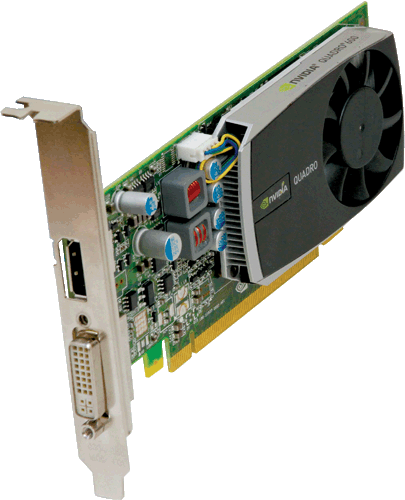
The entry-level NVIDIA Quadro 600.
All four boards use a PCI Express 2.0 x16 bus interface and support DirectX 11 and Shader Model 5.0 as well as OpenGL 4. They also all feature a full 30-bit display pipeline, enabling more color values than 24-bit boards, as well as full-scene antialiasing, hardware 3D window clipping, and HDMI support via an HDMI adaptor. The NVIDIA GigaThread Engine provides up to 10X faster context switching compared to the companys previous generation architectures, while the Quadro Scalable Geometry Engine improves performance across a range of applications. And the NVIDIA Parallel DataCache supports a true cache hierarchy combined with on-chip shared memory to accelerate real-time ray tracing, physics processing, and texture filtering.
At the high and ultra-high-end, the Quadro 4000, 5000, and 6000 also incorporate Dual Copy Engines, which allow simultaneous transfer of data between the GPU and the host computer, further accelerating operations such as ray tracing and physical simulations, and enabling high performance computing thanks to double-precision floating point performance. All the new boards support NVIDIAs Application Configuration Engine (ACE), which automatically adjusts graphics settings for optimized application performance. All four also feature NVIDIA Mosaic Technology, which enables any application to use one or more Quadro boards to scale across up to eight high-resolution displays.
Of course, the biggest differences from the previous generation of Quadro boards are the amount of memory and computational power in each cards GPU. NVIDIA calls its parallel computing architecture CUDA (Compute Unified Device Architecture), and even the new entry-level Quadro 600 provides 96 such processors compared to just 32 in the previous entry-level board.
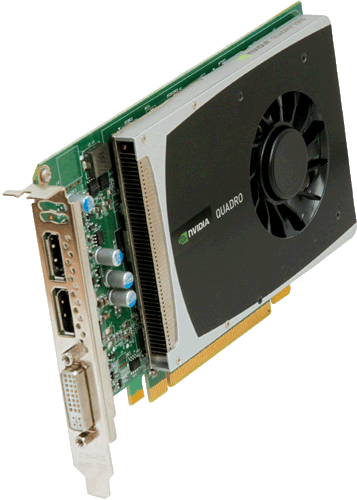
The mid-range NVIDIA Quadro 2000.
The New NVIDIA Quadro Family
At the entry-level, the NVIDIA Quadro 600 provides a full gigabyte of DDR3 memory, compared to 512MB of GDDR3 memory in the older NVIDIA FX 580 board it succeeds in the lineup. As mentioned, the new GPU in the Quadro 600 offers three times the number of CUDA processors as the previous generation board. In our tests, however, the two boards performed about the same, with the older FX 580 even scoring a bit higher on some tests. The new Quadro 600 carries a slightly higher price tag than its predecessor and also compromises a bit, providing one DisplayPort connection as well as a dual-link DVI port, whereas the FX 580 has two DisplayPorts. Still, with a street price around $161, the NVIDIA Quadro 600 is an excellent entry-level board.
The mid-range proved to be the sweet spot. Although decidedly more expensive than entry-level boards, professional graphics boards aimed at this segment of the market typically deliver significantly better performance at a reasonable price point. The new NVIDIA Quadro 2000 comes with 1GB of GDDR5 memory compared to 768MB of GDDR3 memory in the older Quadro FX 1800. Its GPU also provides 192 CUDA cores, compared to just 64 in its predecessor. Although the memory interface drops from 192-bit to 128-bit, NVIDIA engineers have increased the memory bandwidth in the Quadro 2000 to 41.6GB/second. As a result, the new board delivers better performance on most, but not all, of the datasets in the SPEC Viewperf benchmark. The new board also supports NVIDIA SLI technology, a feature not present in its predecessor. Like the older FX 1800 board, the Quadro 2000 requires a single PCIe x16 slot. Although at 62 watts it consumes a bit more power, it does not require an auxiliary power connection. Its manufacturers suggested retail price is a full $100 less than the board it replaces, but its current street price is actually a bit more expensive than the Quadro FX 1800.
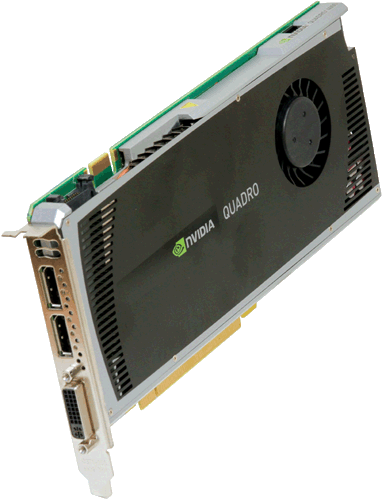
The high-end NVIDIA Quadro 4000.
At the high end, NVIDIA has eclipsed the FX 3800 with the new Quadro 4000. Although its suggested price of $1,199 is identical to the older board, its average street price is around $780, a bit less than the FX 3800. This board comes with 2GB of GDDR5 memory “double that of the older board “while retaining the same 256-bit memory interface. It also provides 256 CUDA cores “64 more than its predecessor “yielding an 89.6GB/second memory bandwidth. As a result, the new Quadro 4000 easily outperforms the older board, often by a wide margin. In addition to its two DisplayPorts and dual-link DVI connector, this board also supports stereoscopic 3D output (with an optional 3-pin Mini-DIN bracket) as well as SLI. In spite of all this power, the Quadro 4000 requires just a single PCIe x16 slot, but since it consumes 142 watts it does require an auxiliary connection to the system power supply.
| Download the benchmarks |
Benchmarking the Boards
We tested the three new NVIDIA Quadro boards using the same system weve used for several years now for evaluating graphics cards, an HP xw6600 workstation equipped with a pair of 3.0GHz quad-core Xeon E5450 processors. While that system is certainly showing its age, using the same computer enables us to continue to compare our results to those of older boards from both AMD and NVIDIA, making it easy to see just how much these graphics accelerators have improved over the years. However, since NVIDIA updated its driver software for the newest boards, we also retested the previous generation of NVIDIA graphics cards using the updated driver, so that we could determine how much things improved simply because of improvements in the driver software.
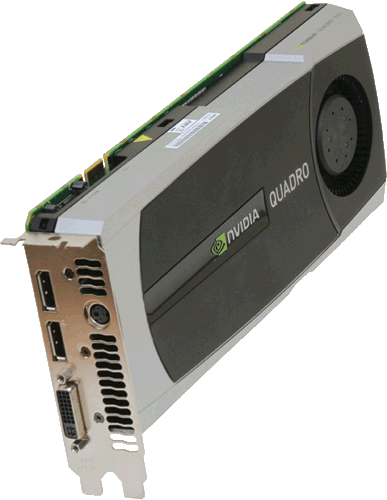
The ultra-high-end NVIDIA Quadro 5000.
But, recognizing that many readers are likely using newer systems, we also did something a bit different this year, running an additional set of tests using the BOXX 3DBOXX 8550XTREME workstation we recently reviewed. The BOXX workstation was equipped with a pair of 3.33GHz Intel Xeon X5680 six-core CPUs over-clocked to 4.2GHz. We tested all of the boards using two different versions of the SPEC Viewperf benchmark (spec.org): version 10 on the older HP workstation running Windows XP 32-bit at 1280x1024 resolution and the newer version 11 on the system from BOXX running the 64-bit version of Windows 7 at 1680x1050.
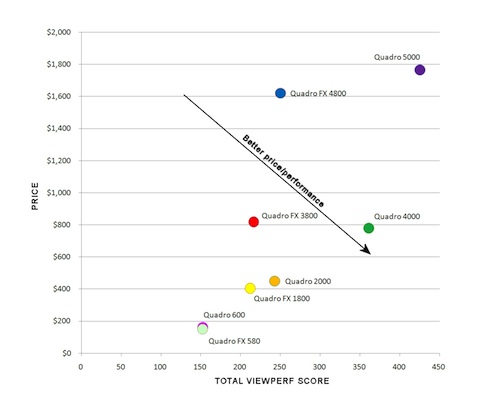
Price/performance of current NVIDIA Quadro boards.
Based on our results, with the exception of the entry-level Quadro 600, the new generation of NVIDIA Quadro boards surpasses the performance of the older boards. In fact, at the mid-range, high, and ultra-high-end, the newer boards at the lower price point once again beat the performance of previous generation graphics cards one step higher on the food chain.
All of the new NVIDIA Quadro boards are fully certified with most CAD and DCC applications and all of the boards in the Quadro line, including earlier Quadro FX boards, use the same unified video driver. Drivers are available for most 32- and 64-bit operating systems, including Windows 7, Vista, XP, and Linux.
David Cohn is the technical publishing manager at 4D Technologies. Hes a contributing editor to Desktop Engineering and also does consulting and technical writing from his home in Bellingham, WA. The author of more than a dozen books has been benchmarking PCs since 1984. You can contact him via email at [email protected] or DSCohn.com.
For more information:
NVIDIA Corp.
Subscribe to our FREE magazine, FREE email newsletters or both!
About the Author
David Cohn is a consultant and technical writer based in Bellingham, WA, and has been benchmarking PCs since 1984. He is a Contributing Editor to Digital Engineering, the former senior content manager at 4D Technologies, and the author of more than a dozen books. Email at [email protected] or visit his website at www.dscohn.com.
Follow DE





